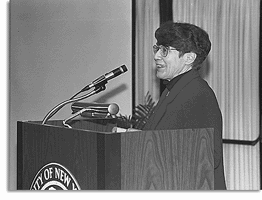
Picturing UB's past: Archivist spins witty tale at Sunrise
By PATRICIA DONOVANNews Services Editor

Finnegan is as well known for her sly, wry, ironic observations as she is for the thoroughness of her scholarship, and her presentation offered ample testimony to both. Archives are her life's work and Finnegan is admired openly and secretly as one of UB's cultural treasures.
 Her "sesquicentennial slide tour" began with a look at the City of
Buffalo in 1846, the year the university was chartered and began operation
as a medical college, and introduced the school's impressive early
dedication to democratic, non-sectarian education and devotion to
intellectual freedom. Her discussion of lofty goals and profound intention
was spiced with amusing anecdotes, such as the one about the mere $20
financial investment made in the new endeavor by Millard Fillmore, the
best-known of UB's founders and its first chancellor.
Her "sesquicentennial slide tour" began with a look at the City of
Buffalo in 1846, the year the university was chartered and began operation
as a medical college, and introduced the school's impressive early
dedication to democratic, non-sectarian education and devotion to
intellectual freedom. Her discussion of lofty goals and profound intention
was spiced with amusing anecdotes, such as the one about the mere $20
financial investment made in the new endeavor by Millard Fillmore, the
best-known of UB's founders and its first chancellor.
She explained the arcane iconography of the first UB seal (that isn't a sev ered femur over Hippocrates' head, it's the lamp of knowledge); showed its first school buildings and introduced Mary Blair Moody, a 40-year-old mother of six, who, in 1876, became UB's first woman graduate and went on to enjoy a successful career in preventive medicine.
The personalities and particular intellectual and administrative talents of UB's chancellors, presidents and deans also were on parade.
One was Teddy Roosevelt's Harvard classmate, the intensely patriotic and religious Charles Norton (Norton Hall), called by Finnegan, "a man of vision and endless effort." He, along with John Lord O'Brian (O'Brian Hall), worked for years to scrape together enough money to buy the acreage surrounding the Erie County Almshouse and Insane Asylum, in an area then called the "Buffalo Plains," for campus development. This feat was accomplished in 1909, when the university was sited in separate buildings all over downtown Buffalo.
Finnegan also discussed the significant contribution by the women of Buffalo toward the development of the College of Arts and Sciences, which transformed UB from a loose confederation of professional schools into a "true university" with a liberal-arts curriculum.
This effort was assisted by Buffalo's socially progressive Women's Educational and Industrial Union, which worked on behalf of working women, women's health issues, women prisoners and education for women and children. The union, headed by Harriet Townsend (Townsend Hall), was operated by many of the city's prominent, reform-minded women, who donated their own building to the university for the express purpose of founding a college of arts and sciences.
Finnegan offered a well-rounded portrait of UB's first chancellor, Samuel P. Capen (Capen Hall), who was largely responsible for defining UB's mission in higher education. She showed pictures of Capen in his simple Hayes Hall office, which was decorated with an elegant spray of lilacs; Capen in academic procession, and a slide of his home on Linwood Avenue. One of the nation's best-known, distinguished and liberal educators, Capen made a distinctive mark on American higher education and is still widely quoted today on issues of free speech, the meaning of a university and support of innovative educational programs.
Finnegan illustrated university life through several decades with slides of students in dark, shiny laboratories and classrooms, almshouse inmates watching the groundbreaking ceremonies for Foster Hall on the Main Street Campus; students carousing, students socializing, engaged in athletics, band performance, at the prom, and sitting, stiff with cold, with President Clifford Furnas and his exuberant wife, Sparkle, at a Bulls football game.
Billboards, capital campaign posters and bulletins spoke to the strong, enthusiastic town-gown relationship between UB and the people of Buffalo and their shared progressive vision of education as key to civic development and the American dream. Finnegan also introduced the audience to Kate Butler, publisher of The Buffalo Evening News, who donated the money for the Hayes Hall bell tower and inscribed bells; to the Foster family, whose donations built Foster Hall-the first new building on the Main Street Campus; the first Phi Beta Kappa banquet, and the Red Friars Club, which today enjoys cult status as a sort of "dead poets' society." It was actually a luncheon club that
fueled the founding by UB women of "The White Nuns' Club."
There was more, much more, from student/faculty activism in the 1960s to UB's incorporation into the SUNY system and the subsequent move to the North Campus, for which then-Governor Nelson Rockefeller broke ground on Halloween, 1968.
A scholar with a yen for the tenderly articulated eccentricity, Finnegan is known for her ubiquitous purple socks (they match a noisy pair of cotton gloves) and for boldly going where no archivist has gone before-to this month's Sesquicentennial Gala in a tuxedo.
A fellow and past president of the So ciety of American Archivists, she serves as a member of the board of managers of the Buffalo and Erie County Historical Society, the Erie County Records Commission and the Town of Amherst Records Commission. Finnegan has served on several national and statewide archival advisory boards and is a recipient of a SUNY Chancellor's Award for Excellence in Librarianship.